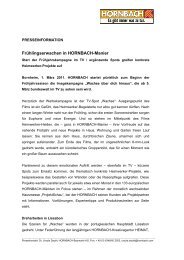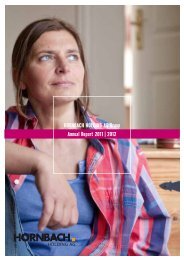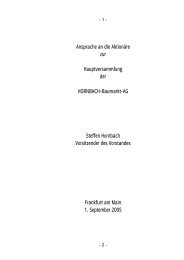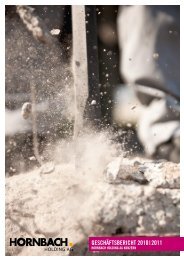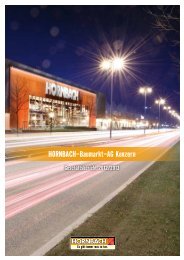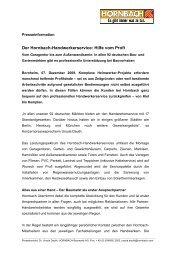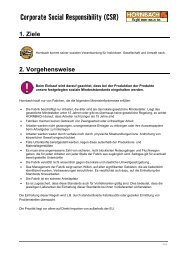Hornbach-Baumarkt-AG Group
PDF, 3,6 MB - Hornbach Holding AG
PDF, 3,6 MB - Hornbach Holding AG
- No tags were found...
You also want an ePaper? Increase the reach of your titles
YUMPU automatically turns print PDFs into web optimized ePapers that Google loves.
GROUP MAN<strong>AG</strong>EMENT REPORT Outlook 77<br />
Opportunities due to sustainability<br />
Construction work on existing buildings (the modernization<br />
and renovation market) has become an ever more important<br />
factor in the business performance of DIY and garden stores<br />
in recent years. The share of construction work involving new<br />
housing, by contrast, is declining across Europe and most<br />
recently accounted for significantly less than half of total<br />
housing construction investments. In Germany, sales in the<br />
modernization market have exceeded new construction volumes<br />
since 1998. In 2011, more than three quarters of the<br />
total construction volumes of around € 166 billion involved<br />
modernization projects. Three key trends are responsible for<br />
this development:<br />
• The age structure of existing real estate indicates an<br />
increasing need for maintenance and modernization. In<br />
Germany, for example, three quarters of all apartments are<br />
more than 30 years old. Less than 5% have been built<br />
since 2000. Almost one in three detached houses in Germany<br />
is in need of renovation. Half of the owner-occupied<br />
houses built between 1949 and 1960 have not yet been<br />
comprehensively renovated and no longer meet current<br />
technology standards in terms of energy efficiency. Given<br />
that the property will decline in value and attractiveness<br />
on the housing market unless renovation measures are<br />
undertaken, the need for construction services and materials<br />
can be expected to increase.<br />
• In view of the long-term increase in energy costs and climate<br />
protection, renovating buildings in terms of their energy<br />
efficiency is becoming an ever more important factor –<br />
one promoted not least by numerous laws, directives, ordinances<br />
and subsidies on European and national levels. Energy-efficient<br />
construction and renovation enable a residential<br />
property's energy costs to be cut by around three<br />
quarters and the property's operating costs to be sustainably<br />
reduced over its lifecycle. At the same time, energyefficiency<br />
renovation makes a major contribution towards<br />
cutting CO 2 emissions. Energy efficiency is therefore one of<br />
the top themes in the European DIY sector.<br />
• Given demographic developments in Europe, barrier-free<br />
construction involves the challenge of adapting existing<br />
living space and urban infrastructure to enable elderly<br />
people to retain their freedom and live independently in<br />
their familiar surroundings for as long as possible. Demand<br />
for senior-friendly construction solutions, such as<br />
barrier-free access to buildings and apartments, the installation<br />
of elevators, and doorway-widening and sanitary<br />
conversion measures, will therefore continue to rise.<br />
These three megatrends can also be summarized under the<br />
heading of "sustainability". The ecological, economic and<br />
social dimension of sustainable construction is ever more<br />
important as a key competitive factor, not only in the real<br />
estate market. At the same time, by offering the right range of<br />
products and services, high-performing industrial and retail<br />
players, as well as tradesmen, stand to benefit from the ever<br />
greater sales potential resulting from this development.<br />
Opportunities due to consumer trends<br />
Past experience shows that people are more likely to withdraw<br />
into their private sphere during periods of uncertainty<br />
than at other times ("homing"). Consumers spend more time<br />
at home again and are prepared to invest in decorating and<br />
equipping their own four walls. This is not just a German<br />
phenomenon but also a key international motivation for home<br />
improvement as a popular leisure activity. This is all the<br />
more relevant at present, as consumers in numerous regions<br />
across Europe are benefiting from low mortgage interest<br />
rates and prefer to channel their resources into private house<br />
construction or renovation projects than into alternative<br />
capital investments that are increasingly viewed as unsafe<br />
or unattractive.<br />
The realization of "living worlds" is playing an ever greater<br />
role in modernization projects in consumers' houses, apartments<br />
and gardens. Consumers are showing growing awareness<br />
of trends and influences from the realms of fashion, art,<br />
architecture and the media. Consumers' desire to map these<br />
living trends onto their own four walls is socially motivated by<br />
a desire for durable values, quality (of living), individualism



